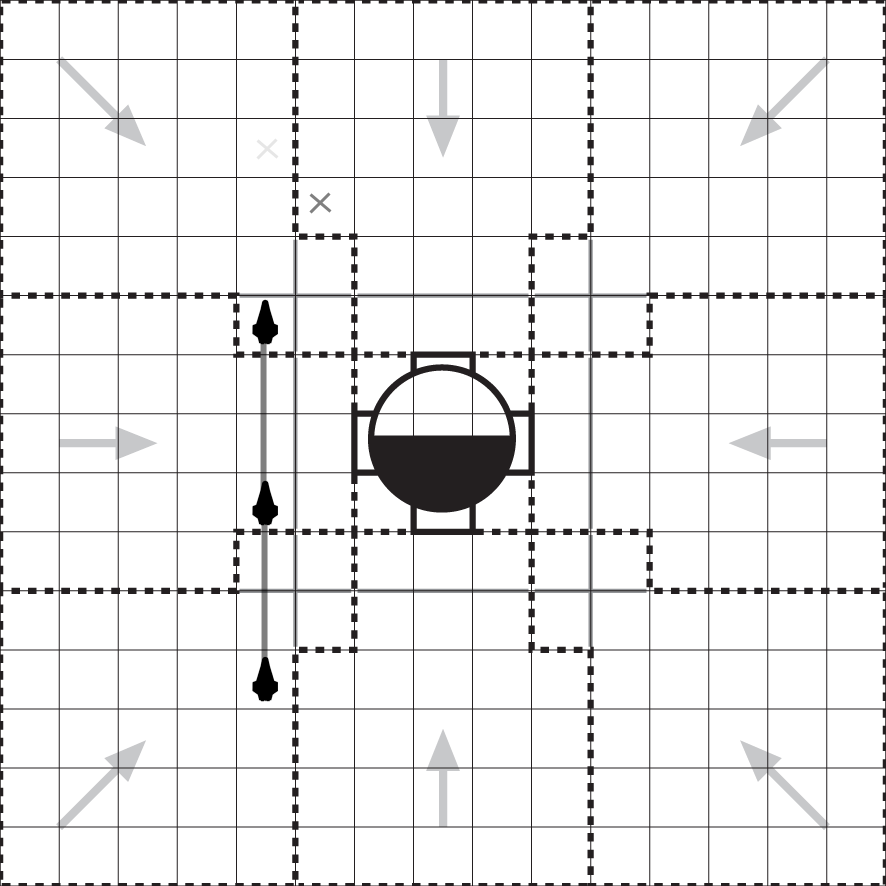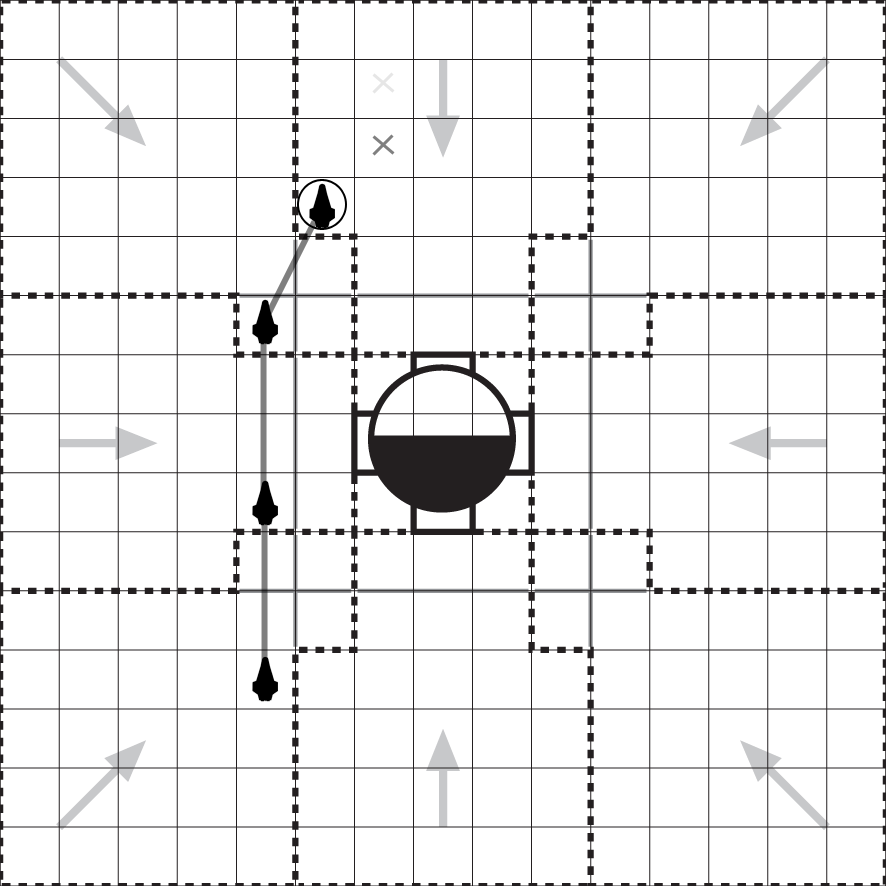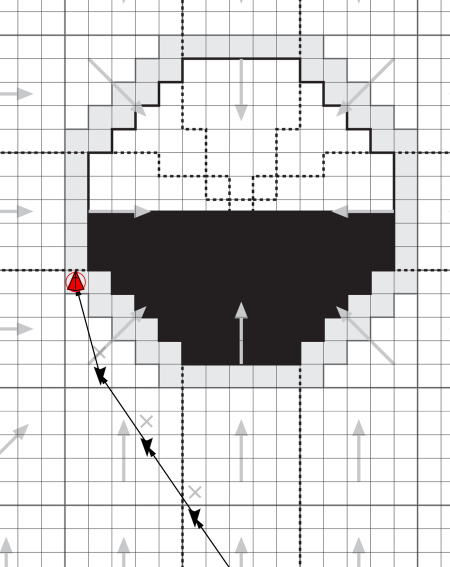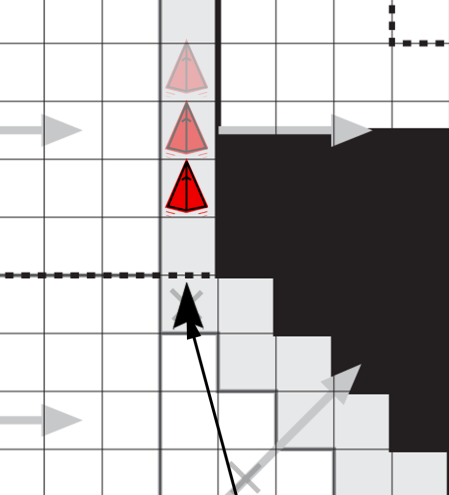
“The ships hung in the sky in much the same way that bricks don’t.”
― The Hitchhiker’s Guide to the Galaxy
Floater
Most smaller ships in Traveller are of the belly lander variety which like the term indicate land and take-off on their belly, all of this is accomplished by the floater ability of all grav thrust vehicles great and small. When ships get into space however, the depictions of Traveller ships seem to forget about this gravity negating ability but not here in Intercept.
Belly landers should have their belly towards the planet to negate gravity while tail landers should have their tail towards the planet to negate gravity. Because Intercept is a 2D game with ships seen from their top (or bottom if rolled) we decide that belly landers simply can negate gravity to their left or right, the important thing here is that their floater thrust is 90 degrees of their thrust axis while the tail landers have floater and regular thrust co-axial.

Movement phase
Let’s go through a movement phase in Intercept to see if and when we can apply floater thrust. We’ll use a belly lander for the example but a tail lander works similarly except what facing it need to have to perform floater thrust. Note that a ship that uses floater is considered thrusting so there is no +2 DM for attacking or being attacked and the ships Signatures will be for a thrusting ship.

We will use compass directions in this example, we call the up direction north, down is called south, to right is east and left is west. We strongly suggest you use the same conventions when you play Intercept as left and right can be confusing when two players sit opposite each other each with their own map.
The ship is drifting 3 squares up or north and it was facing north in the last turn. Repeat the last move and mark with a thin cross, then apply gravity based on the position of the last turn and mark with a cross. This is the ships Drift and if the ship doesn’t use any thrust, regular or floater, this is where it will end up for the turn.
Now the pilot Pilot should decide if he wants to and is able to use Floater to negate the gravity pull. Floaters can only negate gravity so it can only move the drift marker back to the light pre-gravity cross. Whether the ship can do it or not depend on the facing from the last turn.

A belly-lander facing north can negate gravity to east or west, gravity was pulling to the east so the floater can only thrust back to west making the course a straight line again. So there, the Drift and gravity phase of movement is over, the ship could now turn and thrust (and also aerobrake if adjacent to the planet). The captain decides to neither turn nor thrust here, but that doesn’t mean that it is drifting, as previously stated using floater is considered thrust.

In this turn the ship is still facing north and still has a vector of 3 squares north. The ships last turn was in the north-west gravity arc which will pull the drift one square south-east as shown. Let’s see if the pilot can use his floater again this turn.

No, the gravity pull of south-east cannot be negated by any the floater thrust arrows, the ship should have turned to face north-east in the last turn if it wanted to use floater this turn. We mark the ship with a ring as it is actually drifting this turn.

Using floater thrust is rarely worth the effort but can be used in certain situations, especially for ships such as the subsidized merchants. Subsidized merchants, the lower left part of the topmost image, uses reaction-mass guzzling fusion thrusters for thrust i space, in atmosphere the fusion rocket switches to air breathing with a considerably lower fuel use. Subsidized merchants have Floater grav drives that can only negate gravity but that can be used to reduce fuel consumption from thrust at the cost of longer times to jump. Thrust away from the planet (costing no fuel if the planet has an atmosphere thanks to air breathing) and then turning to keep the side towards the planet (the belly in reality). Then they’ll simply Drift away from the planet gliding gracefully out to the jump point.
Floater, grav and impulse drives
Floater thrusters is the first gravity technology and it appear at Tech Level 10. They can only negate gravity and will work exactly as if it was a rocket for those inside the vehicle. The subsidized merchant is a prime example but there are also some grav vehicles with Floater to negate gravity and some other propulsion means such as propellers, ducted fans or jet engines. Floaters are rated in in how much mass they can negate gravity of, a 10 ton Floater on a ship massing 10 ton or less will negate 100% gravity regardless of gravity strength (this help the referee a tremendously as she no longer need to design vehicles for each strength of gravity).
Grav thrusters appears at Tech level 11 and create thrust proportional to gravity. These are you regular sci-fi grav vehicles. They can reach orbit and beyond but get more and more sluggish as gravity diminish the farther out they gp. Also note that regular grav vehicles rarely have the instrumentation to actually match something in orbit, see this post on reaching orbit in an air/raft. Grav thrusters have have built in Floaters too.
Impulse drives finally appear at TL 12 and above and can create thrust regardless of local gravity. They are the kind of drives most Traveller ships use, except for the Subsidized merchant mentioned above and some Vargr ships which uses the high thrust ratings of fusion drives to make high G corsairs with limited endurance.
So, now you know how ships and vehicles of scifi manage to hang in midair, just like bricks don’t. That is all folks, until next time…














